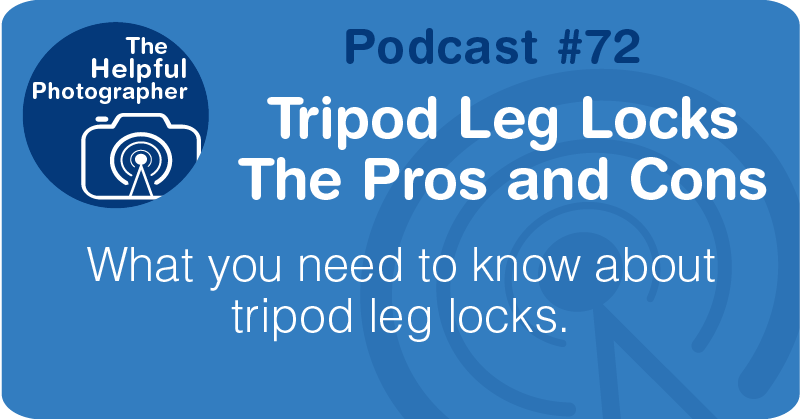Tripod Leg Locks The Pros and Cons #72
Photo Tips Podcast: Tripod Leg Locks The Pros and Cons #72

iTunes
Google
Audible
Tune In
Stitcher
RSS
Pandora
Transcript
Photo Tips Podcast: Tripod Leg Locks The Pros and Cons #72
Back to tripods. Fundamentally there have been three types of leg locks available for tripods. The first is what I call the screw lock. At every joint you would find a screw knob which can be tightened and loosened. Over the past 20 years or so, these types of leg locks have mostly fallen out of favor on the lower end because they took longer to deploy and because they’re much more expensive to manufacture. The second type of leg lock is your flip lock. Like the screw lock it relies on tension to hold the legs at a particular length. The problem with this system is that it’s heavier and not as compact as your twist lock, which is the third type of leg lock. From what I can tell more and more manufacturers are leaning in this direction. In the past I have found them to be very unreliable. Although they are much more reliable these days I have seen some fall apart during a photo safari. Ok, so let's look at the pros and cons.
The main reason why manufacturers have moved towards twist locks is because they’re a lot cheaper to make. And they’re a lot lighter as well; as photographers are always looking to reduce weight, so this is a win win. Whether you’re buying a twist lock or a flip lock you can buy a poorly made or a well made product. One of the ways to tell if you have a quality product unfortunately is price. Yea, price in photography, for the most part, still dictates value. However with flip locks, if you the manufacturer gives you the option adjust the tension of the lock itself this is likely a higher quality lock. Over time the tension used to lock the leg will loosen, that's guaranteed. When that happens you will want the ability to tighten that back up. And not all manufacturers build the tripod to allow you to do that. I asked an engineer why they don't design that into all flip locks? And he said it was simply due to cost. Those few extra pennies for every joint for every tripod made adds up and everyone wants to cut corners.
As far as twist locks, other than loosening the leg completely and taking the legs apart to see how the legs are being put together, there’s no way to check the quality that I am aware of. If they cut corners there you know that they’ve cut corners everywhere else. Having said this, good luck trying to getting the local camera store to let you do this. So once again you are back to reviews, price and the warranty. If the manufacturer believes in their product they'll have a good long warranty on it.
Another thing to note is that if you are in need of a large tripod which will bear a lot of weight, let’s say over 20 lbs, like what cinematographers need, your tripod will likely have a screw lock or a flip lock because twist locks apparently don't scale up particularly well. So although for us still photographers, we don't really see screw locks out there, they definitely haven't disappeared.
Which one should you choose? That's a tough question. For me I prefer flip locks because I know I can fix them if they loosen. But the twist locks are definitely more compact and lighter weight. Bottom line, is it's a personal choice, just make sure you can buy the best quality you can afford. And frankly anything under 50 bucks retail, unless it's very old, is likely to be crap. New quality tripods tend to start at about $150 and up.










